Biography and Artistic Evolution

Between 1974 and 1975, Hunt created several pivotal sculptures that marked a shift in his artistic direction and laid a strong foundation for his work in the years that followed. These included Empire State with Hindenburg (1974), Nankow Pass (Wall of China) (1974), Tower of Babel (1974), Hoover Dam (1975), Phobos (1975), and the first in a series of Airships. These works blended art, science, technology, and philosophy, reflecting Hunt's evolving vision [fig. 3, 4, 5].
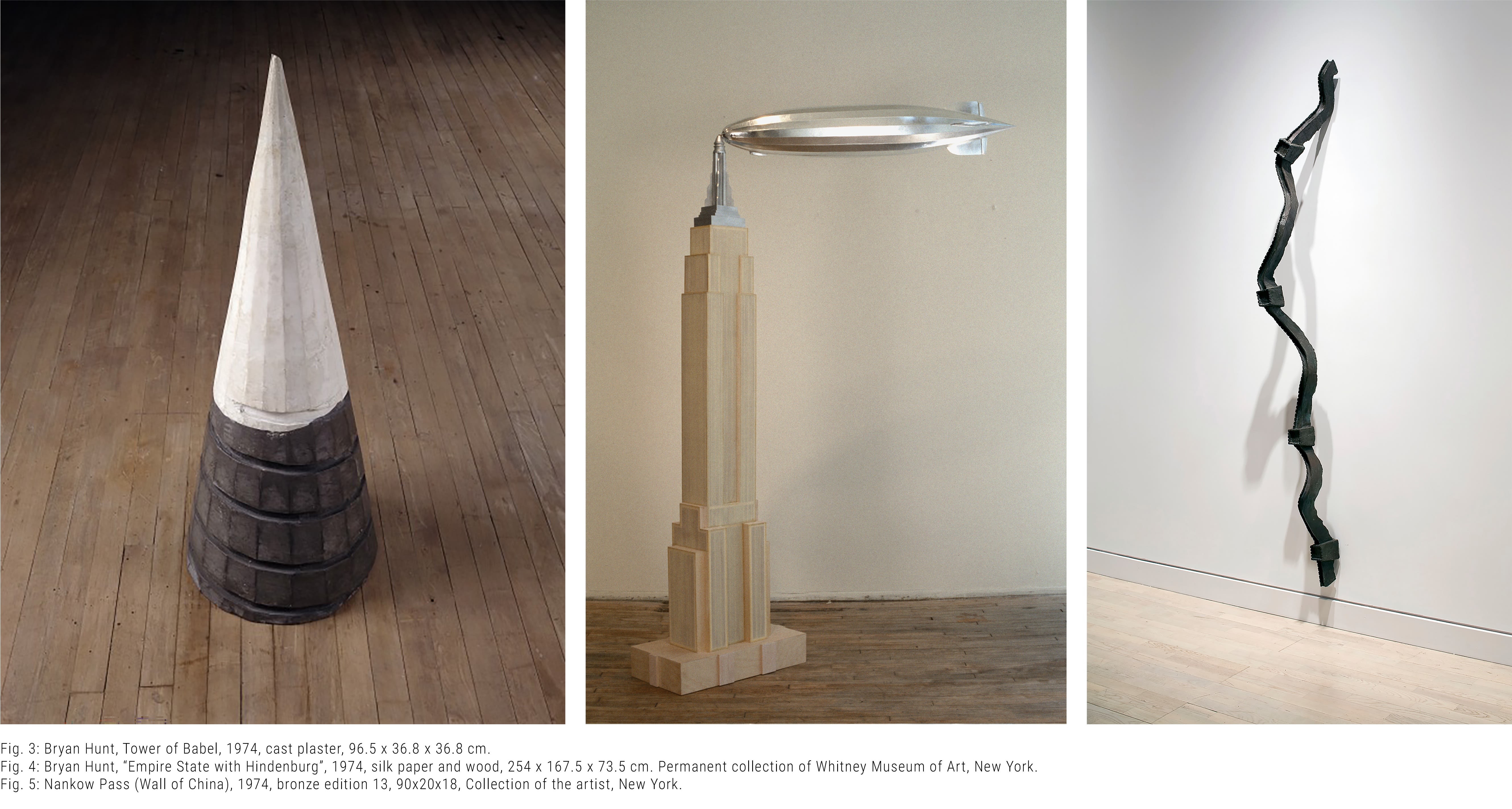
The first of Hunt’s translations of modern spatial concepts into sculptural form was Empire State with Hindenburg (1974) [fig. 4], a striking piece in which a facsimile of the ill-fated zeppelin is tethered to an eight-foot-high replica of the Empire State Building. This work marked a crucial turning point in Hunt’s artistic development, shaping both his conceptual direction and his subsequent projects.
The Empire State Building and the Hindenburg were both monumental engineering feats of their time, yet the juxtaposition of these two icons reflects Hunt’s innovative approach to sculpture. The scale of the work was particularly important: Hunt chose to make the structure eight feet tall, just beyond human reach, which may have been influenced by the Greenbergian idea that all sculpture should relate to the human figure in scale [fig. 6]. This decision created a sense of physical presence while allowing the work to remain just out of direct grasp, enhancing its sense of awe.

A key challenge was to evoke the floating presence of the dirigible. After several visits to model supply stores, Hunt found the solution in a lightweight airship constructed from silk and balsa wood. It was suspended by a small steel rod positioned at an angled cantilever, providing just enough support to give the illusion of weightlessness.
In many ways, Empire State with Hindenburg anticipates the airships Hunt would later create, floating as if suspended in a vast, horizontal volume of space. The piece evokes not only the imagery of spacecraft but also larger ideas of scale and the relationship between objects and the environment. This work can be seen as part of a broader artistic exploration of monumental space, similar to the investigations of leading Earth artists like Robert Smithson and Michael Heizer [fig.7], who were also concerned with the intersection of art, space, and the natural landscape during this period.

Although Hunt wasn’t interested in pursuing a full engagement with the Earthworks movement, he was drawn to the concept of monumental scale and sought to incorporate this into his own work. However, instead of embracing the expansive, land-based forms of Earthworks, he aimed to do so through more compact, classical sculptural forms. The Empire State with Hindenburg was crucial in this regard because it established a dialogue between large-scale, sculptural space and the natural world. He would continue in this manner with plaster and bronze pieces in the shape of quarries [fig. 8], lakes [fig. 9] and waterfalls [fig. 10-14] that captured and isolated fluid fragments of nature, giving them permanence.
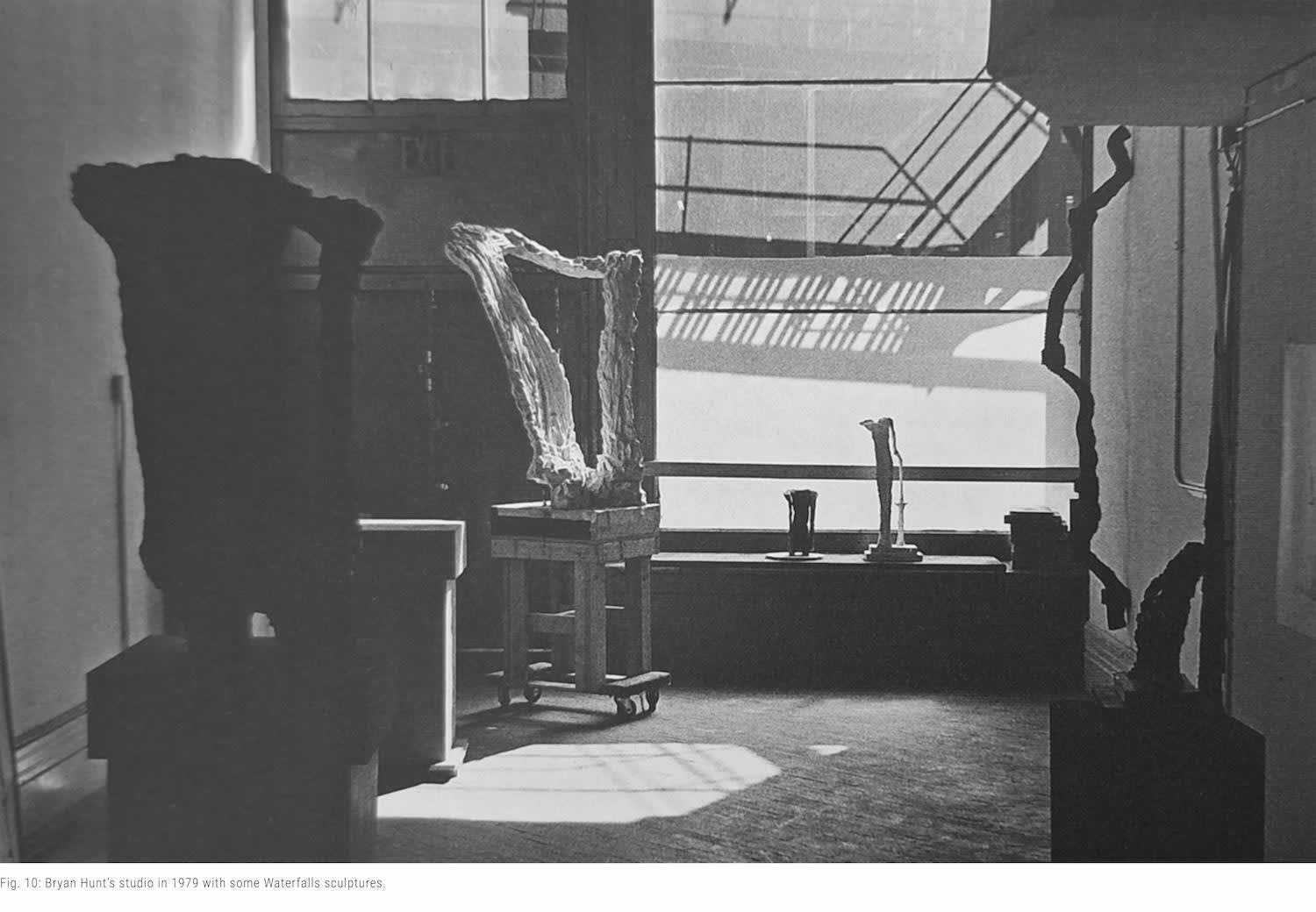
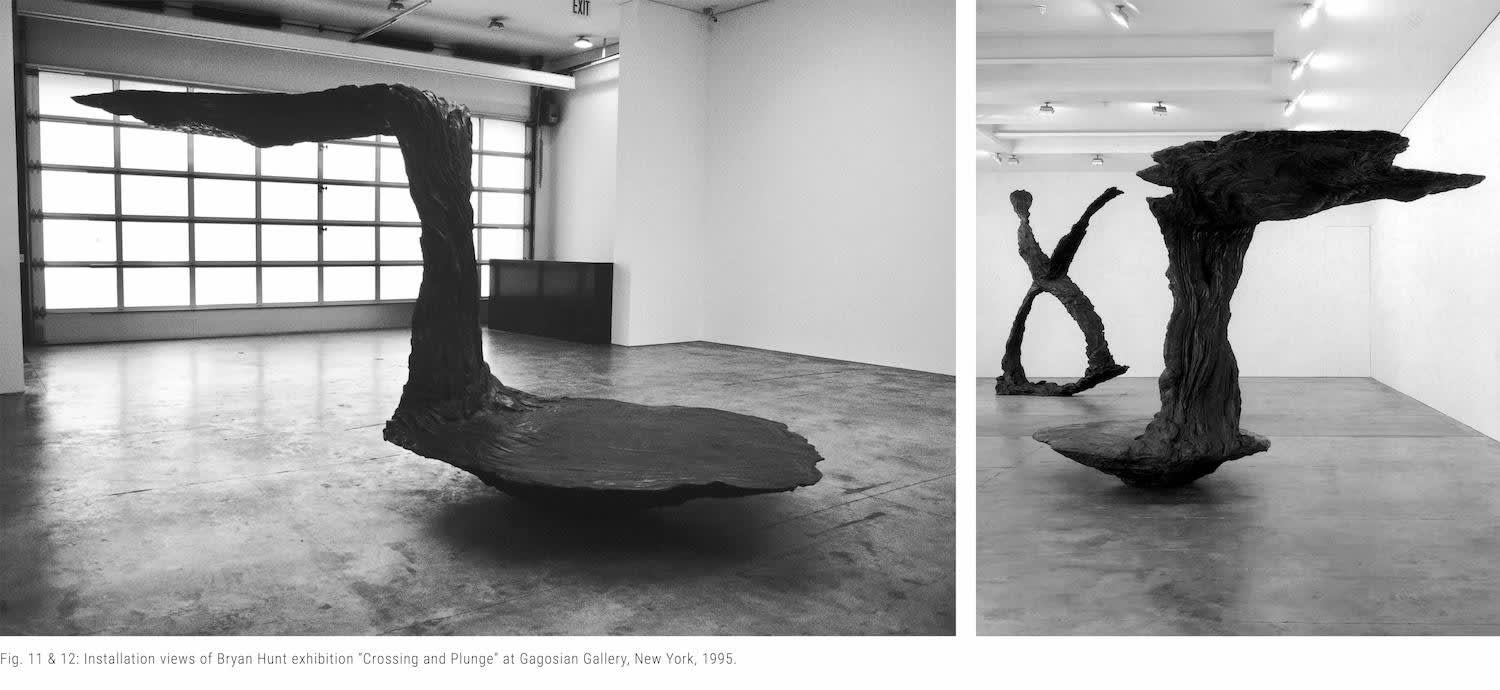
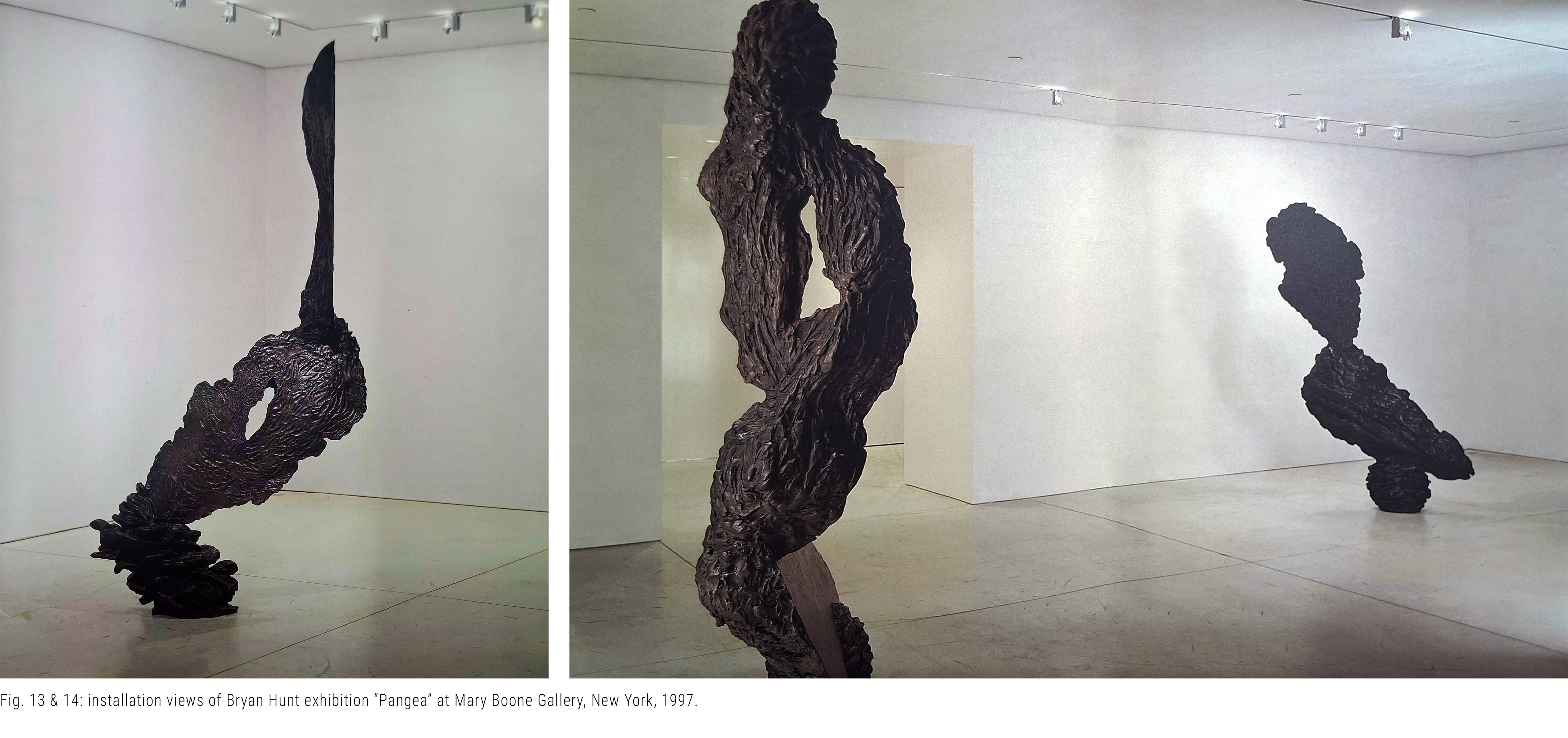
Hunt’s early “architectural structures,” such as the Empire State with Hindenburg (1974), were conceived as free-standing, horizontal sculptures. As he continued to refine these forms, he distilled them further, transforming the structure into shapes that more directly suggested rockets or projectiles. This evolution ultimately led to his Airships series, one of his most distinctive bodies of work. The Airships fused elements of architecture, technology, and landscape, reflecting Hunt’s ongoing exploration of space, scale, and human presence in the world [fig. 15,16].
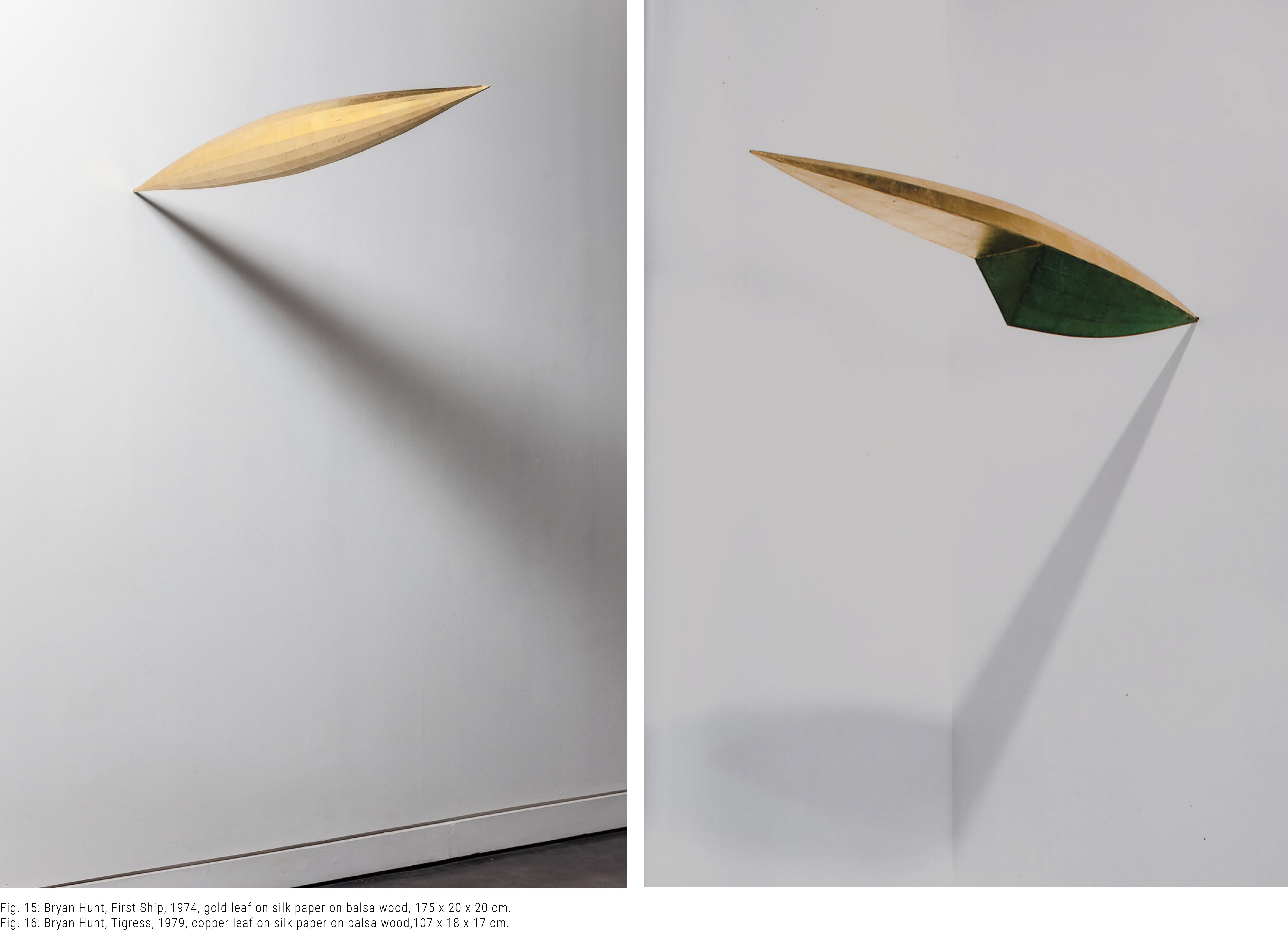
Like the earlier works, the Airships reach into the room and silently float in space, seemingly weightless yet precisely tuned to human scale. Out of human reach but still resonating with human presence, they reflect Hunt's interest in blending the monumental with the intimate. As with many artists of the mid-Seventies, Hunt often used industrial or found materials, in a manner similar to Richard Serra [fig. 17], Donald Judd [fig. 18], and John Chamberlain [fig. 19], who incorporated industrial metals or wrecked cars into their work.
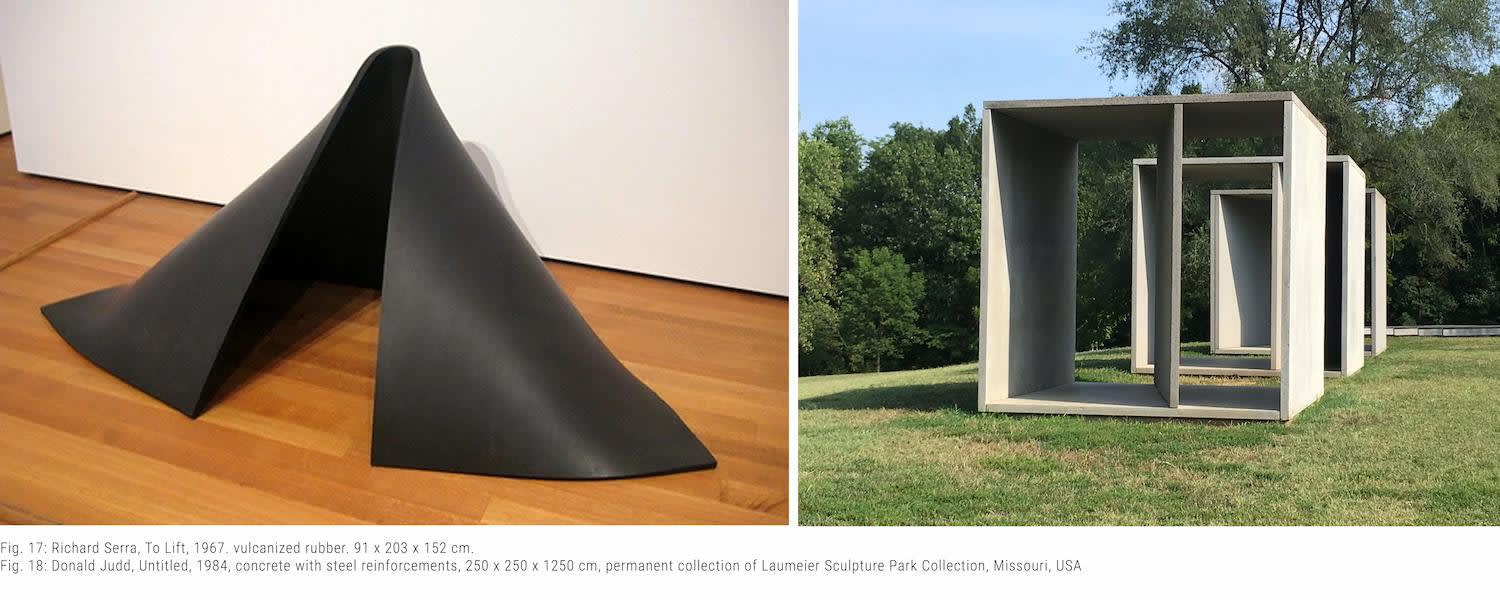
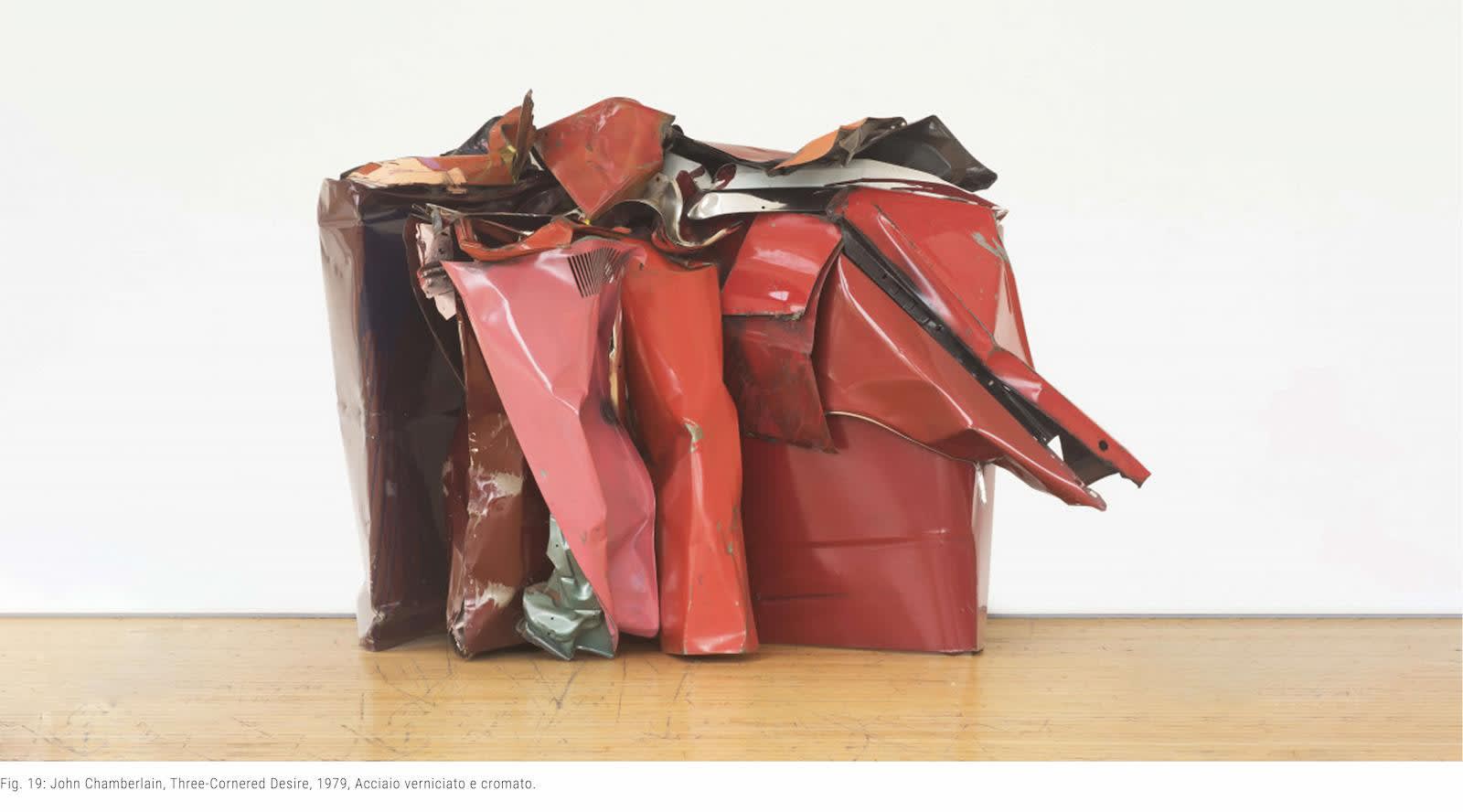
Hunt chose iconic structures and used traditional materials, in fact the Airships were crafted from Balsa wood frames, covered with silk, paper, and metallic leaf, some of which is oxidized [fig. 20]. The reflective nature of the metallic leaf creates a visual connection between the sculpture and the surrounding space and seem to defy gravity as they hover above the viewer.
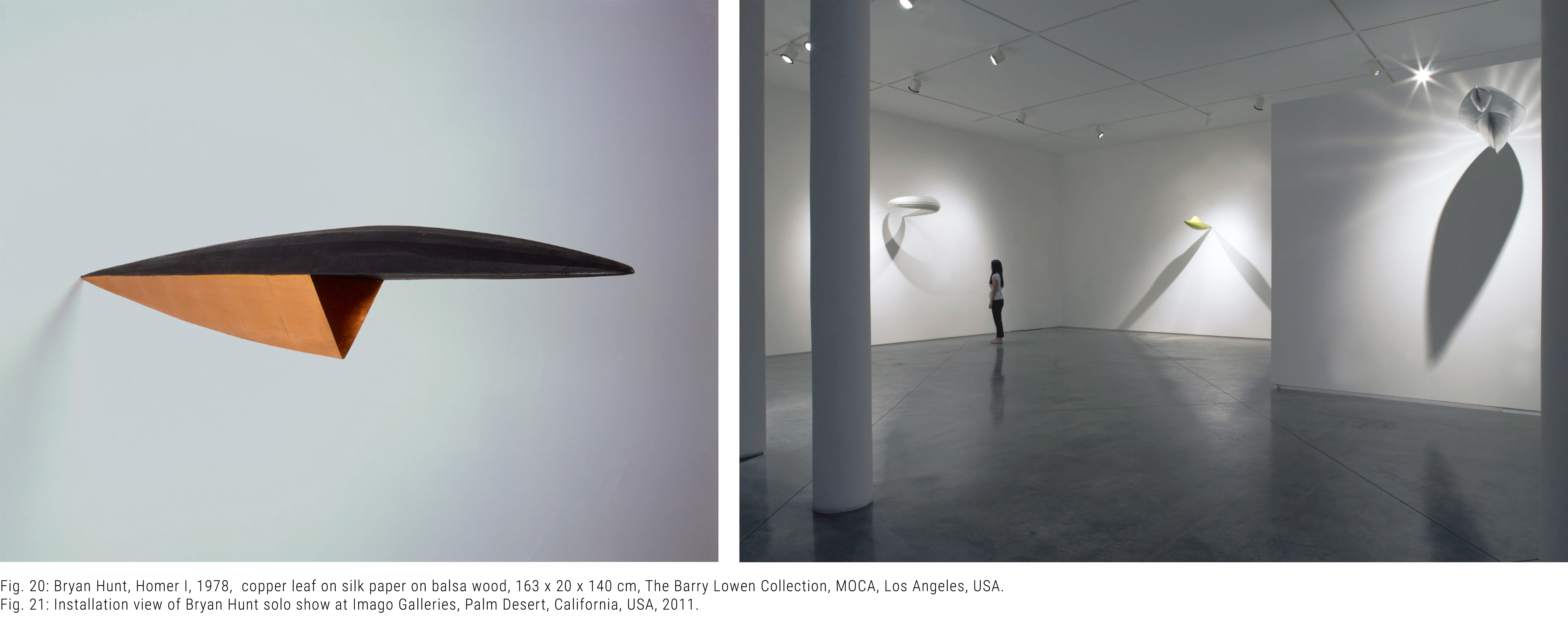
“In the late ‘70s, Hunt began making the ‘Airship’. Miraculously, they are just out of the wall, above our heads, out of reach. We strain to understand their weightless horizontality, their shimmering gossamer instability. Pushing materials to their limits, he changes the gallery into a galaxy where new laws of thermodynamics and gravity and motion are indescribably put into effect. In the ‘Airship’, as in much of his subsequent work, Hunt turns the act of looking into bewildering uncommon, almost supernatural experience”.
- Jerry Saltz
Detaching it from any specific context, Hunt mounted the Airships on the wall. Although out of physical reach, the sculpture remained harmoniously scaled to the human body. From the observer's viewpoint, the implied movement advanced beyond the work and described a large arched line in space. Though Hunt cannot remove the wall, he invites viewers to perceive the airship’s sculptural presence as more dominant than the wall supporting it, effectively transforming the white wall into an unfilled expanse [fig. 21, 22, 23].
As Hunt stated about the airships: “by addressing proportions, balance, and light, the airships transform a room and disregard its boundaries. Ultimately, they have as much to do with looking down on ourselves and our planet as us looking up at a weightless vessel”.
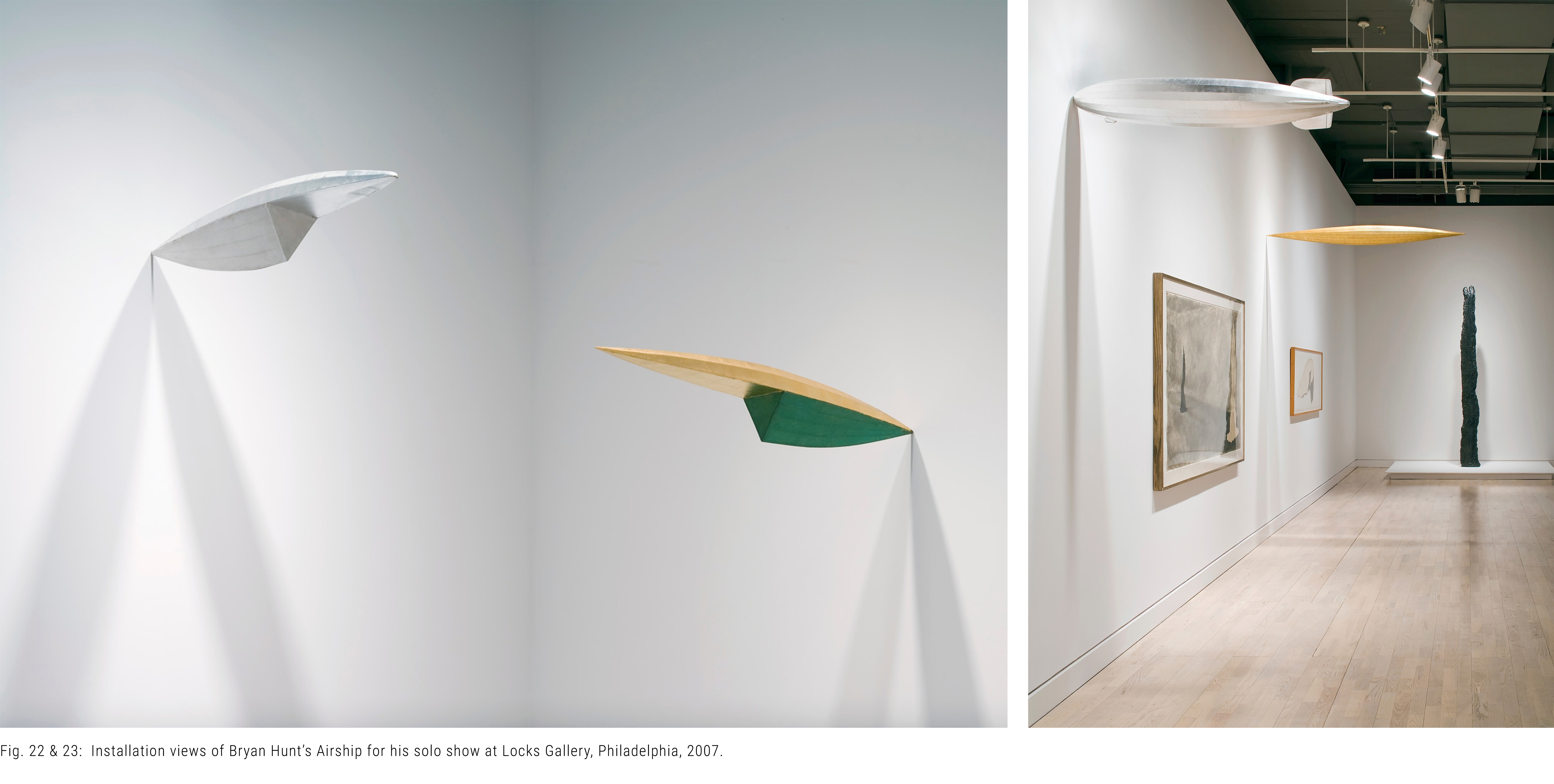
Viewed as a void, the Airship’s path remains ambiguous -it could be approaching, departing, or orbiting, depending on the viewer’s perspective. By positioning it just beyond the reach of even the tallest person, a physical distance is created, akin to observing a full-scale airship from the ground. Once again, Hunt challenges the viewer to suspend reality when it comes to scale and distance [fig. 24, 25].
The sculpture’s dynamic, intentional movement is a key factor in how it interacts with its surrounding space. Starting from a particular point on the wall—serving a similar purpose to the ground from which a vertical statue ascends—the form projects into the room.
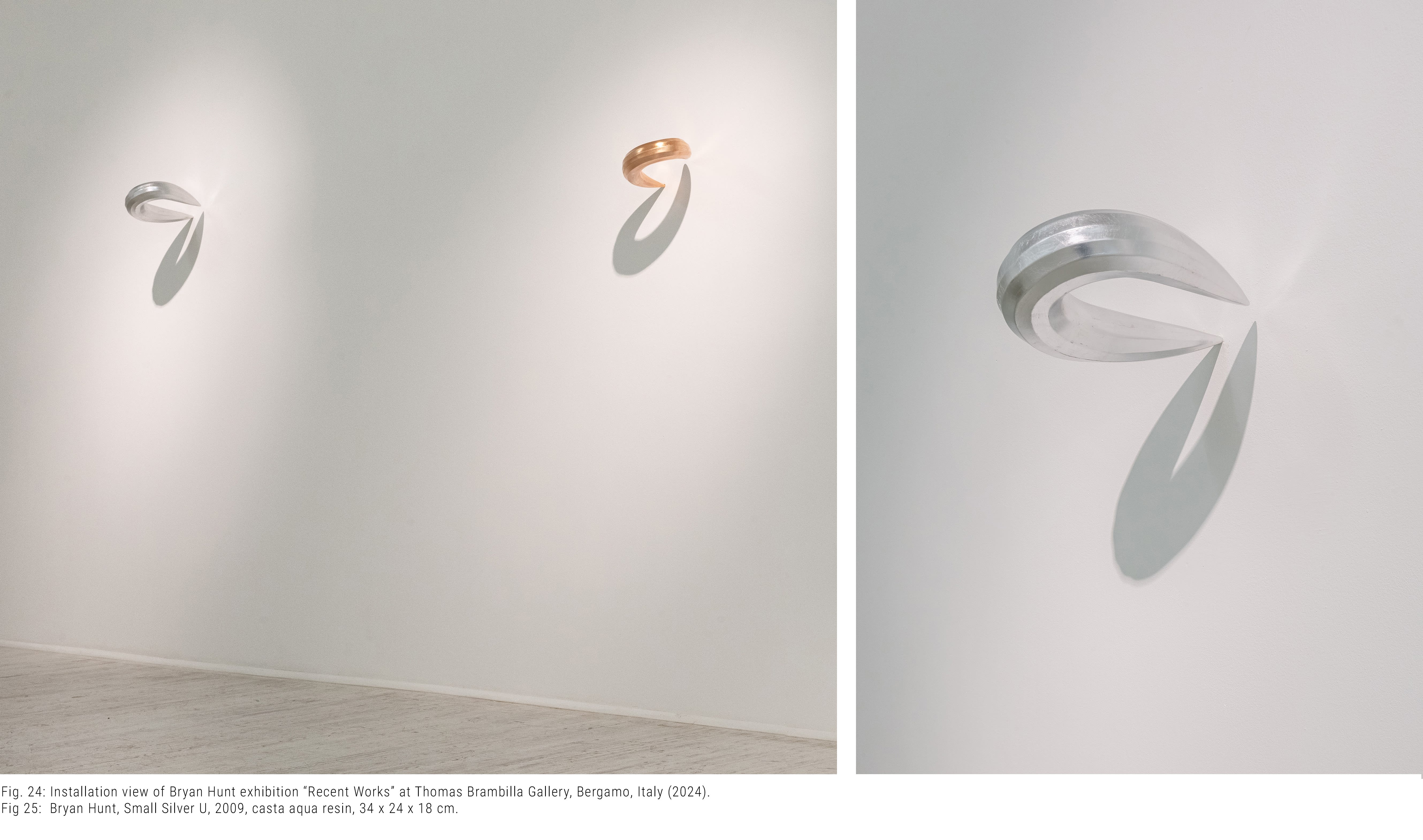
Over the past years, Hunt has further developed the concept of Airships, which has evolved into his more recent Pods series which are installations of small, colorful, glossy dirigible-shaped structures, mounted on the wall [fig. 26, 27]. These Pods evoke lightness and fluidity, extending the artist’s enduring exploration of the relationship between architecture, aeronautics, and philosophy. Hunt’ unique motif not only reflects his innovative vision but also embodies a sustained investigation into the dynamic interplay between form, space, and the viewer's experience.
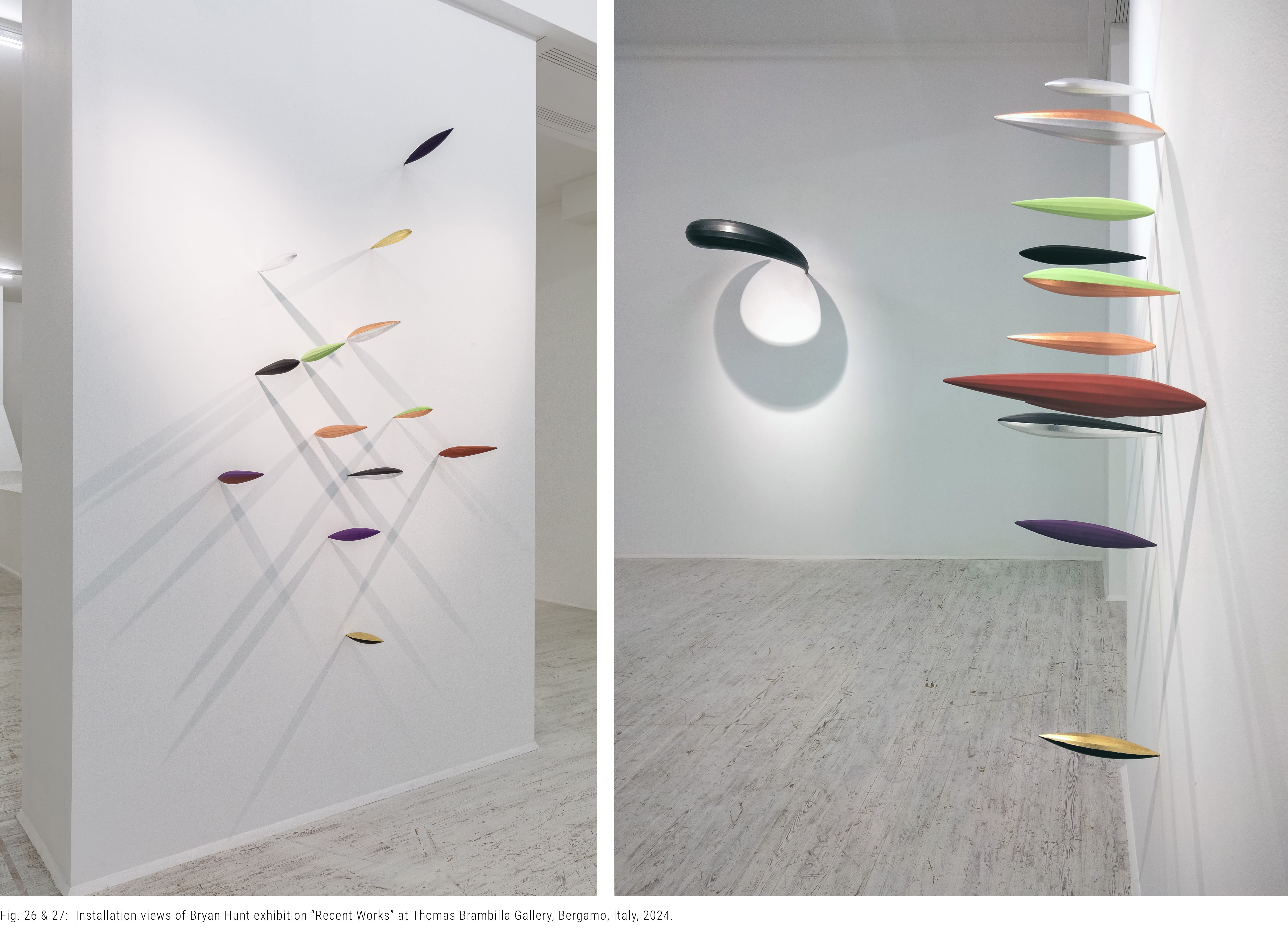
Even Hunt's "free standing" sculptures have always embodied his constant search for artistic evolution. This research becomes particularly evident in his recent series, including Ceta Blues, Blue Venus, and Reclining Venus, where he reimagines the dirigible form as abstract sculptural objects [fig. 28, 29].
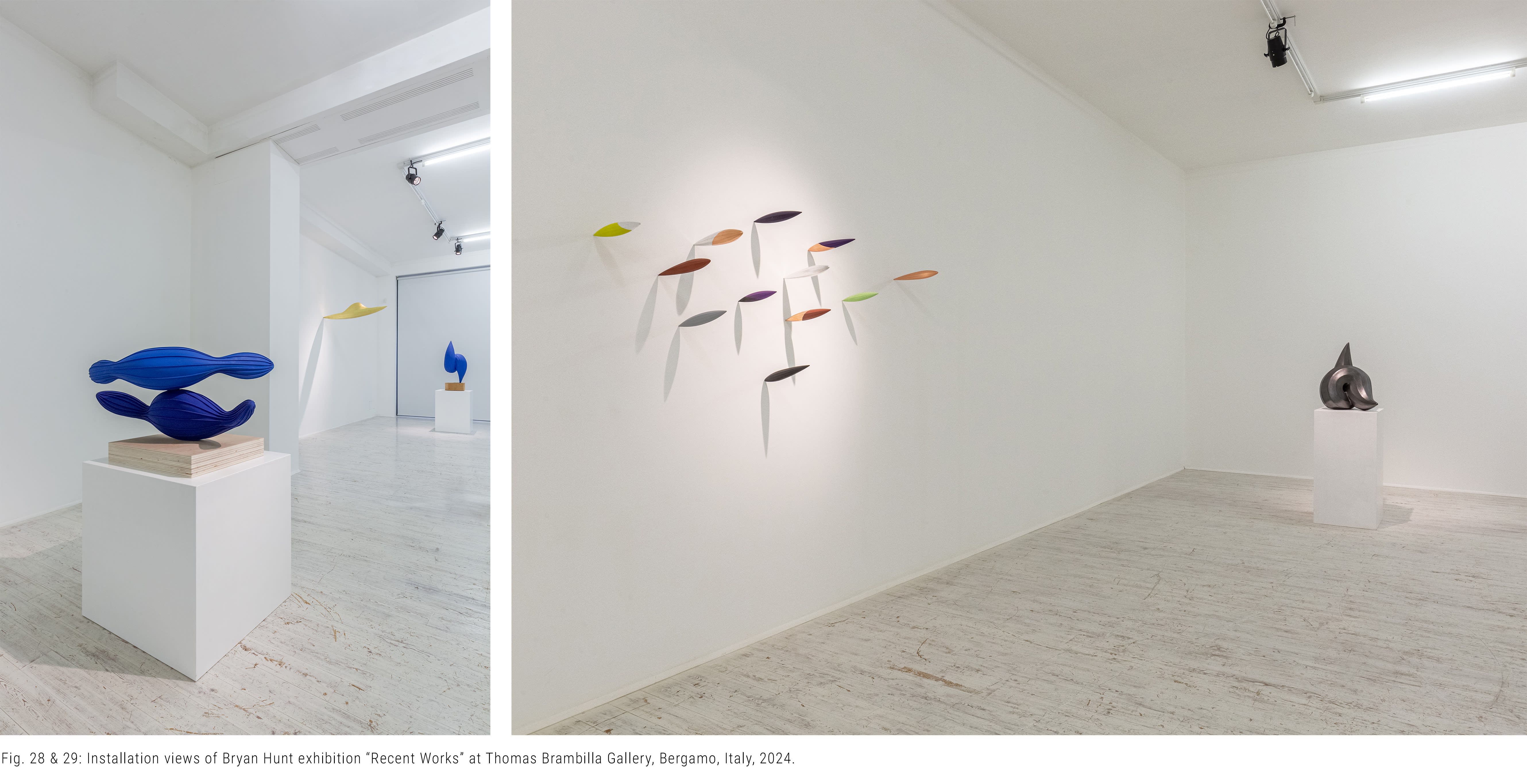
Bryan Hunt's artistic journey represents a unique blend of influences and experiences that have shaped his innovative approach to sculpture. His exploration of dirigible-shaped forms and the creation of his iconic architectural structures, as the Airships and the Pods’ series, have redefined conventional notions of sculpture and its relationship to space. His ability to merge abstract ideas with tangible materials exemplifies a rich dialogue between art and the environment. As Hunt continues to push the boundaries of sculptural expression, his work remains a testament to the transformative power of art and its capacity to inspire reflection on our surroundings.
consulted BIBLIOGRAPHY:
[1] Bryan Hunt: Skulpturen und Zeichnungen, current Exhibition, Wilhelm-Lehmbruck-Museum der Stadt Duisburg, 1987-1988.
[2] Bryan Hunt - Early works: sculpture and drawing 1974-1980, Cat. Exhibition, Orlando Museum of Art, 1992.
[3] Bryan Hunt: Sculpture + Drawings, catalogue of the exhibition curated by Locks Gallery. ADAA member, Philadelphia, 1998.
[4] Bryan Hunt: Twenty Years, catalogue of the exhibition curated by Locks Gallery, 1995.
[5] Bryan Hunt: Protean Nature, catalogue of the exhibition curated by Locks Gallery, Locks Art Publications, Philadelphia, 2002.
[6] Bryan Hunt: Flume, catalogue of the exhibition curated by Danese. Danese, New York, 2006.
[7] Bryan Hunt: Monuments and Wonders, 1974-79, catalogue of the exhibition curated by Locks Gallery, Locks Art Publications, Philadelphia, 2007.
[8] Bryan Hunt: Recalculating, catalogue of the exhibition curated by Danese. Danese, New York, 2012.
